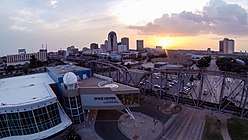Shreveport–Bossier City metropolitan area
The Shreveport–Bossier City metropolitan area, commonly known as Shreveport–Bossier City or Greater Shreveport, is a metropolitan statistical area in northwestern Louisiana that covers three parishes: Caddo, Bossier, and DeSoto.[2] At the 2010 United States Census, the Shreveport–Bossier City metropolitan area had a population of 439,000. The U.S. Census Bureau's 2018 estimate for the metropolitan area was 436,341 making it Louisiana's third largest metropolitan statistical area, and North Louisiana's largest.[3] In 2019, it declined as Louisiana's fourth largest metropolis at 394,706 residents.[4]
Shreveport–Bossier City | |
|---|---|
From top to bottom: Shreveport, Bossier City | |
| Country | United States |
| State | Louisiana |
| Principal communities | |
| Area | |
| • Metro | 2,699 sq mi (6,990 km2) |
| Population (2019) | |
| • MSA | 394,706[1] (125th) |
| Time zone | UTC-6 (CST) |
| • Summer (DST) | UTC-5 (CDT) |
| Interstates | |

Shreveport–Bossier City is the largest economic and cultural center of North Louisiana and the wider Ark-La-Tex region. It is part of the I-20 Cyber Corridor linking the area to Ruston, Grambling, and Monroe, Louisiana; Dallas and Tyler, Texas; and Atlanta, Georgia.[5][6][7] Shreveport–Bossier City's economy is primarily based on oil and natural gas, manufacturing, casinos, restaurants, commerce, telecommunications, technology, banking, healthcare and medical research, and advertising. The largest companies operating within the metropolitan area are Calumet Specialty Products Partners, SWEPCO, AT&T Mobility and Cricket Wireless, Louisiana State University, JPMorgan Chase, Regions Financial Corporation, and Walmart.
Geography
The Shreveport–Bossier City metropolitan area has a total area a little over 2,699 square miles. The area is slightly larger than the U.S. state of Delaware, and smaller than Connecticut and the U.S. territory of Puerto Rico. The U.S. Office of Management and Budget defines the metropolitan region as covering Caddo, Bossier, and DeSoto parishes. Previously, Webster Parish was considered part of Greater Shreveport.
The metropolitan area is located in the South Central United States, bordering East Texas and South Arkansas. As such, it is within the Piney Woods ecoregion. Its vegetation is classified as temperate forest and grassland. Much of the urbanized area was built on forested land, marshes, swamp, or prairie, remnants of which can still be seen throughout the metropolis.
Communities
Cities
- Shreveport (Principal city)
- Bossier City (Principal city and suburb)
- Mansfield (Principal city)
Towns
- Benton
- Blanchard (suburb)
- Greenwood (suburb)
- Haughton (suburb)
- Keachi
- Logansport
- Oil City
- Plain Dealing
- Stonewall (suburb)
- Vivian
Villages
Demographics
In census of 2010,[8] there were 557,201 people, 189,000 households, and 139,000 families residing within the metropolitan statistical area. The racial makeup of Greater Shreveport was: 60.58% White, 28.74% African American, 1.02% Native American, 1.88% Asian, 0.14% Pacific Islander, 0.80% from other races, 1.22% from two or more races, and 6.08% Hispanic or Latino of any heritage. The median income for a household in the area was $32,974, and the median income for a family was $39,203. Males had a median income of $35,583 versus $31,848 for females. The per capita income for the metropolis was $16,521.
Economy
Shreveport–Bossier City is the economic and cultural center of Northwest Louisiana and the wider Ark-La-Tex area. It is also the largest economic metropolitan area in North Louisiana. The area's economic activity is centered in the city of Shreveport, the parish seat of Caddo Parish.
Much of the Shreveport–Bossier City metropolitan area's economy is based on oil and natural gas, manufacturing, casinos, restaurants, and commerce. Telecommunications, technology, banking, healthcare and medical research, and advertising have been rising industries since the early 2000s. Filming has also been a prevalent industry in the area. The largest companies operating within the metropolitan area are Calumet Specialty Products Partners, SWEPCO, AT&T Mobility and Cricket Wireless, Louisiana State University, JPMorgan Chase, Regions Financial Corporation, and Walmart. AT&T, Chase, and Regions have regional offices within Shreveport's downtown area.
Media
The principal cities of Shreveport and Bossier City have their own newspapers, The Shreveport Times and Bossier Press-Tribune, respectively. Other major publications in the metropolitan area include The Barksdale Warrior, The Shreveport Sun, Caddo Citizen, SB Magazine, The Forum Newsweekly, City Lights, The Inquisitor and The Shreveport Catalyst.
The central city of Shreveport is home to several radio stations, particularly KWKH and KEEL. The three commercial television outlets for the metropolis are KSLA (CBS), founded in 1954; KTBS-TV (ABC), founded in 1955, and KTAL-TV, which arrived in Shreveport in September 1961 as the NBC station. KTBS was an NBC station, with occasional ABC programs, from 1955–1961, when it switched affiliation to ABC. KTAL, formerly known as KCMC of Texarkana, was a CBS outlet prior to conversion to NBC, when it began to cover Shreveport as well as Texarkana.
See also
- Louisiana census statistical areas
- List of census-designated places in Louisiana
- List of cities, towns, and villages in Louisiana
References
- https://www.census.gov/data/tables/time-series/demo/popest/2010s-total-metro-and-micro-statistical-areas.html
- "Shreveport, Bossier City Metro Area - USA.com". Retrieved 8 December 2015.
- Bureau, U.S. Census. "U.S. Census website". United States Census Bureau. Retrieved 2018-10-01.
- Bureau, US Census. "Metropolitan and Micropolitan Statistical Areas Totals: 2010-2019". The United States Census Bureau. Retrieved 2020-06-20.
- cfloyd. "Rise of the I-20 Technology Corridor". Cyber Innovation Center. Retrieved 2020-03-04.
- Hilburn, Greg. "Gov. Edwards: New center strengthens Shreveport-Bossier as cyber hub of La". shreveporttimes.com. Retrieved 2020-03-04.
- "Louisiana Governor launches the first ever Cyber Security Education Center in the state with Cybint and BPCC". finance.yahoo.com. Retrieved 2020-03-04.
- "U.S. Census website". United States Census Bureau. Retrieved 2008-01-31.

.jpg)
